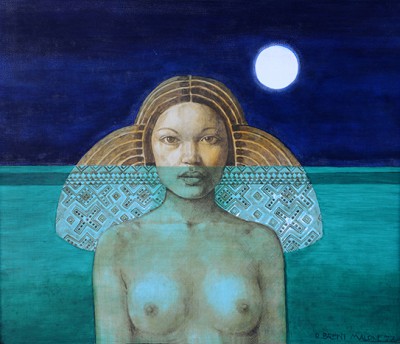Bahamian Icons: Past, Present and Future
03/29/2012-04/17/2012
Oftentimes, a single piece of artwork can define an individual artist, a sweeping era, or a life-changing moment in time. Deeply embedded in our cultural consciousness, such work becomes legend and the artist an icon. The work is reproduced so often that to see it in person is a rich moment for the viewer.
Such is the thought behind the current exhibition at The D'Aguilar Art Foundation,"Bahamian Icons: Past, Present and Future", which effectively explores Bahamian art history through its most memorable work by Bahamian masters and identifies the artists who will continue to define the cultural landscape.
Because the D'Aguilar collection contains a complete cross-section of Bahamian artwork, the exhibition acts as a history lesson in notable Bahamian masterpieces and predicts those to come, says the curator of the exhibition, Holly Parotti.
"We looked at each artist, each piece, and we made sure each piece really reflected that artist's work and what they're doing and what they're capable of doing," said Parotti. "A lot of people can come in and access these pieces because they recognize them, just because they have been synonymous with that artist and their portfolio."
Indeed both Bahamians and visitors alike will find a rich legacy of art and culture in this sampling of work alone. From Brent Malone's"Lucayan Goddess", Roland Rose's"Bereaved", Rolfe Harris '"Junkanoo Drummer (Freedom Dreams)" and John Beadle's "Conjure Woman", to work by Lavar Munroe, Dede Brown, Dionne Benjamin-Smith and Claudette Dean, the exhibition captures the evolution of Bahamian art through the decades.
"We're able to show artists who have collaborated theoretically,"pointed out Parotti. "Like Toby Lunn and Kendal Hanna despite that gap of 40 to 75 in their ages, you're able to put those two pieces next to each other and you're able to see how one influences the other still. That's one of the rich qualities of our community, that everyone speaks to each other and collaborates with and influences each other."
Yet the collection is as much about the collector as about the art itself. Underneath each piece lies a tale about its addition to the collection, imbuing the exhibition with a tone of poignancy. John Beadle's "Conjure Woman" may be the most recognizable and requested piece from the collection, but in this exhibition, viewers can discover the deeply personal and amusing reason behind its purchase by the newlywed Vincent D'Aguilar.
Indeed from Lynn Parotti's shining portrait of Vincent D'Aguilar to the endearing tale behind Lillian Blades'"Remembering"of a father-in-law's thoughtful token, the exhibition reminds viewers that the art pieces may be icons to the wider public, but to the art lover, they remain family photographs, heirlooms, and keepsakes.
"There are some stories behind some of these pieces that make you feel really good about the D'Aguilar family being behind this movement," said Parotti. "A lot of pieces in here meant a lot to Vincent as well as to the family. We wanted to make it a personal experience for the D'Aguilar family, as well as an educational experience."
"We have the fortune of using the D'Aguilar art collection that can support a surveyed exhibition like this with a theme and a concept,"she continued."Having the work here at hand and having such strong work to display as well as to discuss, this is one of the things that the foundation is here for an educational resource."

